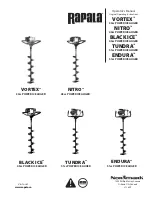
RespiraSense
™
Instructions For Use
RespiraSense
™
PDS-801-007 Revision 2
Page
15
of
77
●
In default configuration, the RS Device can emit an audible and visible alert if the measured
respiratory rate exceeds pre-determined thresholds. The user can override the default settings
to suppress Sounders and visible alerts.
●
The respiratory rate information that the RR Monitor obtains must be evaluated by clinicians
on a case-by-case basis.
●
The RS Device may record abnormal data. Any abnormal data must be evaluated by a clinician.
Clinicians should assess additional physiological parameters or run additional tests before
making a diagnosis and prescribing treatment.
●
The RS Device is not to be used for neonatal or infant monitoring.
●
Do not use the Device during defibrillation.
●
Do not use the Device during MRI, X-Ray or other medical imagining procedures.
●
Do not use the Device in Oxygen Rich environments.
Principles of Operation
The Device provides a continuous, non-
invasive method of monitoring patient’s respiratory rate.
Respiratory Rate
Respiratory Rate (RR) is the number of breaths taken within a set amount of time, typically 60 seconds.
This is also known as respiration rate, respiration frequency, ventilation rate, ventilation frequency,
pulmonary ventilation rate or breathing frequency. Respiratory rate is a vital sign and can help in the
assessment of the health status of a patient. Respiratory rates can change with fever, illness, or other
medical conditions.
For ventilation to occur, some sort of mechanical displacement of the thoracic and/or abdominal
region must take place.
The respiratory rate is the effect of the intercostal muscles across the ribcage contracting. This causes
the sternum to lift and expand outwards across the ribs. These mechanical actions create a vacuum in
the thoracic region of the body, which is compensated by air flowing from the environment into the
lungs via the facial cavities
–
the nose and the mouth.
Ventilation also occurs mechanically when the abdomen displaces and creates a vacuum and/or drop
of the diaphragm. The diaphragm is a band of muscle under the lungs that separates the thoracic
regions from the abdominal region. The displacement of the abdomen has the same result as the
displacement of the ribcage: air flows into the lungs through the nose and mouth.
If any problems are indicated by circulatory condition or skin integrity, remove the Sensor from the
patient.
CAUTION
Do not use damaged Sensors.
CAUTION
Do not immerse the Sensor in water, solvents, or cleaning solutions (the Sensors and
connectors are not waterproof).
CAUTION
Do not sterilise Sensors by irradiation, steam, autoclave, or ethylene oxide (unless
otherwise indicated on the Sensor directions for use).
CAUTION
Do not attempt to reprocess, recondition, or recycle Sensors as these processes
could damage the electrical components, and lead to patient harm.
















































